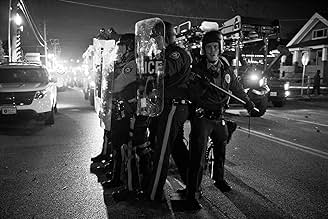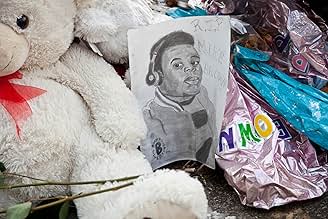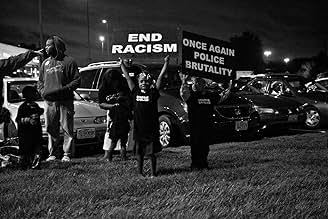Ajouter une intrigue dans votre langueAn unflinching look at how the police killing of 18-year-old Mike Brown inspired a community to fight back and sparked a global movement.An unflinching look at how the police killing of 18-year-old Mike Brown inspired a community to fight back and sparked a global movement.An unflinching look at how the police killing of 18-year-old Mike Brown inspired a community to fight back and sparked a global movement.
- Réalisation
- Scénario
- Casting principal
- Récompenses
- 2 victoires et 18 nominations au total
- Self
- (as Brother Shadid)
- Self
- (as Mama Cat)
- Self - Ferguson Police Chief
- (images d'archives)
- Self - Governor of Missouri
- (images d'archives)
Avis à la une
This documentary was emotional and powerful and told the story from a point of view many of us cannot possibly understand because we have not lived it. The only problem I have with this movie is that it doesn't contain more information from the people involved. I wanted even more interviews and more footage.
At one point, one of the activists said that you can burn down a convenience store yet it can be rebuilt, however all the magicians in the world can't bring back a dead person. Therefore, the real question of violence should be: was anyone hurt? This encapsulates the overall theme of the documentary which is that people come before everything. Clearly the Mike Brown killing became a rallying point but he was also a symbol for much deeper grievances, which is the community didn't feel the police force treated them as people. You won't hear much from the other side in this documentary but it doesn't pretend to be that.
Having never participated in a protest, much less a riot, I felt I had done both after experiencing directors Sabaah Folay and Damon Davis's Whose Streets? Their documentary about Ferguson, Missouri, and the death of Mike Brown in 2014 is an unremittingly real and passionate participant point of view that celebrates the will of an oppressed people to be heard.
Whose Streets? documents the thoughts and actions of the largely black population as they experience the white-cop brutality of Ferguson and St. Louis police forces, culminating in Mike Brown's being shot 8 times by an officer who justifies the assassination with his fear. The grand jury believed he was faultless, leading to disbelief and riots reminiscent of the reaction to Rodney King's killers' exoneration.
The doc is especially effective bringing home the pain with portraits of such sufferers as Brittany Ferrell, a comely and articulate young lesbian who is not afraid to speak her outrage. We see her at home with her children and on the street with the microphone chanting the will to fight to be free, an anthem echoed by virtually everyone facing down the daunting police and national guard forces.
The street's-eye view happens largely because cell phones recorded the abuse with a probing expertise heretofore only the province of professional filmmakers. But not today, when those little devices are adjuncts to the spirit of justice, albeit not always enough to bring convictions. David Whitt, a Copwatch citizen videographer, meticulously records and publishes images that damn the militaristic response, for the film's expert doc makers put them together to devastatingly powerful effect.
Although white cop Darren Wilson, 28, had Brown in his sights after Brown allegedly robbed a convenience store, Brown should not have died for the crime nor should his body have lain in the street for hours while the community and security reacted. However, most of the forensic evidence and testimony proved that Wilson acted in self defense.
If there can be a criticism of this doc, it would be that the evidence finally exonerating Wilson is not presented; he remains guilty in the spirit of the film if not the reality. Although the filmmakers could claim an interest only in the people's plight and reactions, full disclosure for me requires that I also see where the police can be at least partially exonerated.
Justice both civil and spiritual is elusive. Whose Streets? is an estimable rendition of a disadvantaged populace struggling to be heard.
The sad part comes later. Poor people exploited.
Exploited by the thieves and robbers who make use of the revolt to destroy property. Not only they disgrace the manifestation, but they will make the lives of the people living there even worse without shops and restaurants nearby.
Exploited by the police. The police who does not care or interfere with the problems of the people living there only to ask for more money, more wages, more equipment and bigger pensions.
Exploited by the speakers. Young men and women taking about "our kids". Even if the "kid" was quite an adult. Progressive speakers who care about their possible speaking engagements and TV shows. Speakers who put salt on the wounds in the names of "being united". History shows these people usually move beyond the racial lines, in low crime towns and keep talking about the suffering while sending their kids to private schools.
Exploited by the film makers who get to travel and walk the documentary.
And the people are left there. With less police. Less places to shop. Less employments opportunities nearby.
Le saviez-vous
- AnecdotesMichael Brown, the decedent whose death sparked 4 days of violent riots, never put his hands up in surrender and in fact, charged and grabbed the gun of the police officer that shot him.
- Citations
David Whitt: It was obvious military tactic. Come in, cut off their communication, round them up, you know what I'm saying? Then, once we had them under control, have them lose people, have a combat photographer come in and say like 'Hey, look, they going crazy' Yeah, they going crazy because we just cut off their communication and shot a couple of them. And then, later on, everything calm and all that and then everybody home, like 'Oh hey, they rounded up the insurgents' We in their country. How are they insurgents? You know what I'm saying? That's what's going on in Ferguson, man.
- ConnexionsFeatured in Subject (2022)
Meilleurs choix
Détails
- Date de sortie
- Pays d’origine
- Sites officiels
- Langue
- Aussi connu sous le nom de
- Чьи улицы?
- Lieux de tournage
- Ferguson, Missouri, États-Unis(primary footage)
- Société de production
- Voir plus de crédits d'entreprise sur IMDbPro
Box-office
- Montant brut aux États-Unis et au Canada
- 182 799 $US
- Week-end de sortie aux États-Unis et au Canada
- 43 804 $US
- 13 août 2017
- Montant brut mondial
- 182 799 $US
- Durée
- 1h 42min(102 min)
- Couleur



















